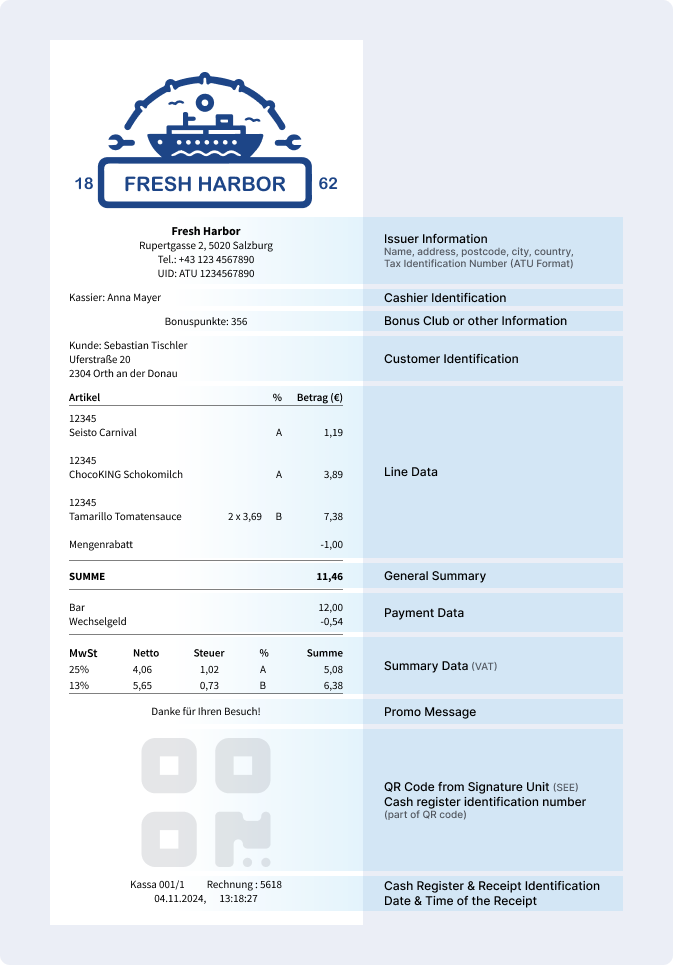Receipt Layout
Layout

In Austria, the Cash Register Security Ordinance (RKSV) regulates the requirements for electronic cash registers and the receipts issued. According to the RKSV, receipts must contain certain features in order to be tamper-proof and legally compliant. These document features are defined in § 132a BAO and the RKSV.
Mandatory features of a receipt according to RKSV
A receipt must contain the following information:
| Information | Description |
|---|---|
| Name of the company | Name and address of the issuing company. |
| Ongoing document number | Each receipt must have a unique, consecutive number. This number is used for traceability and must be unique within the cash register. |
| Date and time | The time the receipt was issued (date and time) must be specified. |
| Quantity and description of the goods or service | Description of the goods or services supplied and their quantity. |
| Amounts of the individual tax rates | Breakdown of the gross amount according to tax rates (e.g. 10%, 13%, 20%). |
| Total amount of the cash transaction | The total amount of the transaction paid in cash or cash equivalent (e.g. by card). |
| Cash register identification number | The cash register must have a unique identification number in order to assign it within the company. |
| Signature data or QR code | The security device of the cash register must generate an electronic signature for each receipt. This is either: - as a signature block (readable code) or - as a QR code on the receipt. The QR code contains, among other things, the signature data and allows the receipt integrity to be checked. |
| Link to the previous receipt | Each receipt must contain a cryptographic reference (in the signature) to the previous receipt in order to ensure a complete chain of receipts. |
The RKSV requires the printing of the signature on the receipt as a QR-code ("machine-readable code" within tag <Code> in result-XML <TraC>). Printing the QR code for signature data requires about 57 bits square without quiet (white) border. So it is recommended to reserve 200x200 print-pixels if a QR bit is represented by 3x3 print-pixels.
Alternatively, a "signature dependent link" may be printed through which the whole signature can be retrieved. This is provided in the tag <Link> and only requires one line of print, for example: EFSTA.NET#123456789012345678901234
When the link is entered in a web-browser address field, the signature and QR Code are displayed.
Example Response
All Fis.Tag elements in the response must be printed on the receipt. The Fis.Code element must be printed as QR Code.
XML Response
<TraC SQ="2345">
<Result RC="OK"/>
<Fis>
<Code>_R1-AT2_01/1_2053_2016-02-01T09:28:00_3,49_6,63_2,23_...==</Code>
<Link>EFSTA.NET#35424655090786385905</Link>
</Fis>
</TraC>
JSON Response
{"TraC": {
"SQ": 13,
"Result": {"RC": "OK"},
"Fis": {
"Code": "_R1-AT3_001/1_2088_2024-04-24T15:56:43_3,49_6,95_0,00_0,00_0,00_...",
"Link": "EFSTA.NET#345989802021540593218164",
"Tag": [
{
"Name": "Info",
"Value": "Prime-Sign Test",
"Label": ""
}
]
}
}
}